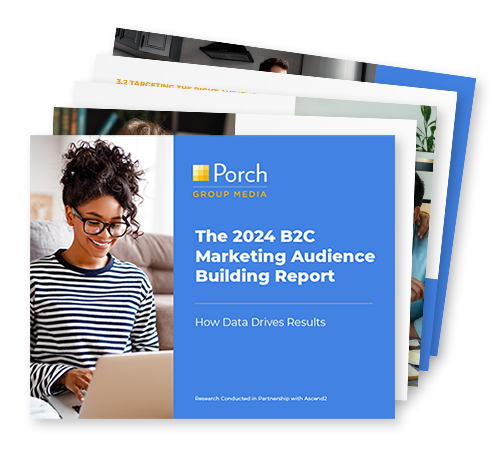With the right data and strategy, digital display advertising can be a major driver of conversions and sales. In fact, according to research by OMI and Ascend2, one-third (33%) of enterprise marketers feel that their digital display advertising is extremely effective in driving conversions and sales.
The top ad formats marketers are using include:
- 70% use banner ads
- 69% report using video ads
- 45% use pop-up ads
- 32% use native ads

Overview of Display Ad Formats
Here is a quick overview of the various types of display advertising formats:
Banner Ads
Banner ads are one of the most common forms of online advertising. They typically consist of static or animated images or graphics displayed at the top, bottom, or sides of a webpage. They come in various sizes, with the most common being the leaderboard (728×90 pixels) and the rectangle (300×250 pixels).
Banner ads are used to attract the attention of website visitors and direct them to a specific landing page or website.
Video Ads
Video ads are short video clips that play before, during, or after online video content, such as on YouTube or streaming platforms. They can be in-stream (within the video player) or out-stream (in the content or sidebar).
Pop-Up Ads
Pop-up ads are windows that open suddenly and overlay the content of a webpage. They can be triggered by various actions, such as clicking a link, entering a site, or scrolling down a page. Pop-up ads are designed to grab the user’s attention and deliver a message, promotion, or offer. However, they are often considered intrusive and can negatively impact user experience.
Native Ads
Native ads blend seamlessly with the content of the platform on which they appear. They match the visual style and format of the surrounding content, making them look like a natural part of the page. Native ads aim to provide a non-disruptive advertising experience. They are intended to engage users by delivering relevant content that aligns with the platform’s context, such as sponsored articles, videos, or social media posts.
Interstitial Ads
Interstitial ads are full-screen ads that appear between content transitions, such as when moving between web pages or app screens. They often cover the entire screen and require user interaction to dismiss. Interstitial ads are used to deliver immersive and attention-grabbing messages. They are often seen in mobile apps and mobile web browsing, offering advertisers a larger canvas for creativity.
Challenges to Display Advertising Success
Measuring accurate ROI and performance metrics was listed as the most significant challenge regarding digital display advertising, according to 42% of those surveyed.
Just as significant was finding the right target audience for the ads, according to 41% of respondents.

Marketers experienced the most success when their display advertising was integrated with other channels. 88% of marketers reported that their digital display advertising efforts are integrated with other marketing channels.

6 Display Advertising Trends Shaping the Digital Landscape
1. Programmatic Connected TV (CTV)
With 87% of U.S. households now having a connected TV device, advertisers are taking note. CTV ad is projected to reach $21.5 billion this year, a 25% increase over last year. Programmatic CTV allows advertisers to deliver highly targeted and personalized video ads to viewers on streaming devices. Advertisers can target specific audience segments based on factors such as their own 1st party data, demographics, interests, and behaviors.
2. Video Dominates the Scene
Along the same theme as CTV, video advertising is continuing to rapidly increase. As consumers turn to streaming and video content on platforms like YouTube and TikTok, advertisers are following suit. Short-form videos, in particular, are gaining prominence, with many brands adopting the TikTok-style ad format to engage younger audiences.
3. Engage Consumers with Interactive and Immersive Ads
The days of static banner ads are dwindling. Interactive and immersive ad formats, such as gamified ads, shoppable ads, and augmented reality (AR) experiences, are captivating users and driving higher engagement rates. These ads encourage users to actively participate, fostering a deeper connection with brands.
- Interactive ads invite users to engage with the content in some way such as clicking on elements within the ad, swiping, filling out forms, or even playing games. Interactive elements can include quizzes, polls, product galleries, and more. For example, an interactive car ad might allow users to explore the vehicle’s features by clicking on different parts of the car.
- Immersive ads aim to fully immerse the user in a branded experience. They often utilize cutting-edge technologies like virtual reality (VR), augmented reality (AR), and 360-degree videos to transport users to different environments or scenarios. For instance, an immersive travel ad might let users take a virtual tour of a destination, allowing them to explore the sights and sounds as if they were there.
4. Contextual Targeting for Privacy-First Advertising
Privacy concerns, regulatory changes, and cookie deprecation have prompted a shift towards more privacy-conscious advertising. Contextual targeting, which focuses on placing ads in relevant content rather than tracking user behavior, is gaining traction as a privacy-first approach to display advertising.
5. Boosting the Customer Experience with Native Advertising Integration
Native advertising seamlessly blends with the content of the platform it appears on, providing a non-disruptive user experience. Brands are increasingly incorporating native ads into their strategies, recognizing the effectiveness of this format in engaging users without interrupting their online activities.
6. The Increasing Importance of Personalization and Data-Driven Insights
Personalization remains an important trend in display advertising. Leveraging data analytics, marketers can deliver highly targeted ads tailored to individual preferences and behaviors.
For example, dynamic advertising involves automatically generating ad content on the fly. An e-commerce site might display personalized product recommendations based on a user’s browsing history or past purchases.
Display advertising is constantly evolving, driven by advancements in technology, shifting consumer behaviors, and the changing digital landscape. To succeed in this dynamic environment, marketers must not only stay informed about the latest trends but also be willing to adapt and innovate.






